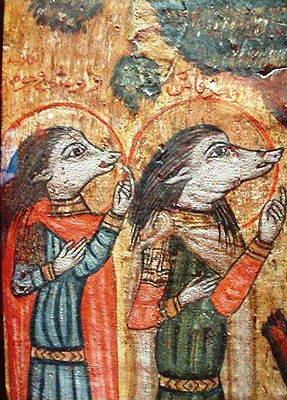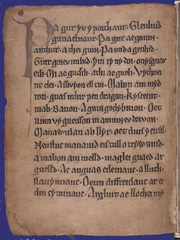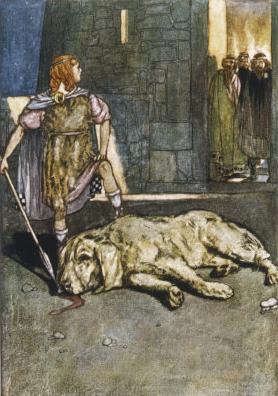|
Garwlwyd
Gwrgi Garwlwyd ("Man-Dog Rough-Grey") is a warrior character in Welsh Arthurian legend. He appears in the poem ''Pa gur'' and in the Welsh Triads as a fierce warrior, and may have been seen as a werewolf. Accounts In ''Pa Gur'', King Arthur and his men fight against an army of ''cinbin'', or dogheads, at the mountains of Eidyn (modern Edinburgh). In the next passage, Arthur's men fight Garwlwyd ("Rough-Grey") in the Battle of Tryfrwyd, possibly a second fight against the monsters. Arthur's warrior Bedwyr (later known as Bedivere) spars with Garwlwyd, evidently their champion. Welsh Triads 10W and 32 feature Gwrgi Garwlwyd ("Man-Dog" "Rough-Grey"), who can be identified with the character from ''Pa gur''. He is described as a menace who killed one Briton every day, and two on Saturday to avoid killing on Sunday. His death at the hands of Diffeidell mab Dissynyndawd, a bard and chieftain of Deira and Bernicia, is regarded as one of the "Three Fortunate Slayings". Scholar Rachel Brom ... [...More Info...] [...Related Items...] OR: [Wikipedia] [Google] [Baidu] |
Battle Of Tryfrwyd
''The History of the Britons'' ( la, Historia Brittonum) is a purported history of the indigenous British ( Brittonic) people that was written around 828 and survives in numerous recensions that date from after the 11th century. The ''Historia Brittonum'' is commonly attributed to Nennius, as some recensions have a preface written in his name. Some experts have dismissed the Nennian preface as a late forgery, arguing that the work was actually an anonymous compilation. Overview The ''Historia Brittonum'' describes the supposed settlement of Britain by Trojan expatriates and states that Britain took its name after Brutus, a descendant of Aeneas. The work was the "single most important source used by Geoffrey of Monmouth in creating his ''Historia Regum Britanniae''" and via the enormous popularity of the latter work, this version of the earlier history of Britain, including the Trojan origin tradition, would be incorporated into subsequent chronicles for the long-running his ... [...More Info...] [...Related Items...] OR: [Wikipedia] [Google] [Baidu] |
Cynocephaly
The characteristic of cynocephaly, or cynocephalus (), having the head of a canid, typically that of a dog or jackal, is a widely attested mythical phenomenon existing in many different forms and contexts. The literal meaning of "cynocephaly" is "dog-headed"; however, that this refers to a human body with a dog head is implied. Such cynocephalics are known in mythology and legend from many parts of the world, including ancient Egypt, India, Greece, and China. Further mentions come from the medieval East and Europe. In modern popular culture cynocephalics are also encountered as characters in books, comics, and graphic novels. Cynocephaly is generally distinguished from lycanthropy (werewolfism) and dogs that can talk. In addition, the Greeks and Romans called a species of apes cynocephalus (these apes are suspected to be baboons). Etymology The word ''cynocephaly'' is taken (through Latin) from the Greek word κυνοκέφαλοι ''kynokephaloi'', plural of the word κυνο� ... [...More Info...] [...Related Items...] OR: [Wikipedia] [Google] [Baidu] |
Bedwyr
Bedivere ( or ; cy, Bedwyr; la, Beduerus; french: link=no, Bédoier, also Bedevere and other spellings) is one of the earliest characters to be featured in the legend of King Arthur, originally described in several Welsh texts as the one-handed great warrior named Bedwyr Bedrydant. Arthurian chivalric romances, inspired by his portrayal in the chronicle ''Historia Regum Britanniae'', portray Bedivere as a Knight of the Round Table of King Arthur who serves as Arthur's marshal and is frequently associated with his brother Lucan and his cousin Griflet as well as with Kay. In the English versions, Bedivere notably assumes Griflet's hitherto traditional role from French romances as the one who eventually returns Excalibur to the Lady of the Lake after Arthur's last battle. Bedwyr In early Welsh sources, Bedwyr Bedrydant ("Bedwyr of the Perfect Sinew") is a handsome, one-handed warrior under Arthur's command. His father is given as Pedrawd or Bedrawd, and his children as Amhre ... [...More Info...] [...Related Items...] OR: [Wikipedia] [Google] [Baidu] |
Eidyn
Eidyn was the region around modern Edinburgh in Britain's sub-Roman and early medieval periods, approximately the 5th–7th centuries. It centred on the stronghold of Din Eidyn, thought to have been at Castle Rock, now the site of Edinburgh Castle, and apparently included much of the area below the Firth of Forth. It was the most important district of the Brittonic kingdom of Gododdin, and a significant power in the Hen Ogledd, or Old North, the Brittonic-speaking area of what is now southern Scotland and northern England. The site of Din Eidyn has been nearly continuously occupied since the Bronze Age, serving as a stronghold of the Votadini during the Roman era and later the principal centre of their successors, the Gododdin kingdom. Eidyn's importance to the Hen Ogledd is reflected in the medieval poem ''Y Gododdin'', which concerns a war band that gathered there for a raid around AD 600. After years of decline, Eidyn was conquered by the Angles in 638. Eidyn left a consid ... [...More Info...] [...Related Items...] OR: [Wikipedia] [Google] [Baidu] |
Pa Gur
Poem 31 of the Black Book of Carmarthen, a mid-13th century manuscript, is known from its first line as ''Pa gur yv y porthaur?'' (meaning "What man is the gatekeeper?") or ''Pa gur'', or alternatively as ''Ymddiddan Arthur a Glewlwyd Gafaelfawr'' ("The dialogue of Arthur and Glewlwyd Gafaelfawr"). It is a fragmentary, anonymous poem in Old Welsh, taking the form of a dialogue between King Arthur and the gatekeeper Glewlwyd Gafaelfawr, in which Arthur boasts of his own exploits and those of his companions, especially Cai the Fair. ''Pa gur'' is notable for being one of the earliest vernacular Arthurian works, and for alluding to several early adventures of Arthur which are now lost. Its precise age is not known and has been the subject of wide-ranging disagreement, but scholarly opinion now tends to favour a date of c. 1100. Summary ''Pa gur'' is in places a very difficult text, and translations of it vary widely. This summary is based on the version of Jon B. Coe and Simon ... [...More Info...] [...Related Items...] OR: [Wikipedia] [Google] [Baidu] |
Arthurian Legend
The Matter of Britain is the body of medieval literature and legendary material associated with Great Britain and Brittany and the legendary kings and heroes associated with it, particularly King Arthur. It was one of the three great Western story cycles recalled repeatedly in medieval literature, together with the Matter of France, which concerned the legends of Charlemagne, and the Matter of Rome, which included material derived from or inspired by classical mythology. History The three "Matters" were first described in the 12th century by French poet Jean Bodel, whose epic ' ("Song of the Saxons") contains the line: The name distinguishes and relates the Matter of Britain from the mythological themes taken from classical antiquity, the "Matter of Rome", and the tales of the Paladins of Charlemagne and their wars with the Moors and Saracens, which constituted the " Matter of France". King Arthur is the chief subject of the Matter of Britain, along with stories relate ... [...More Info...] [...Related Items...] OR: [Wikipedia] [Google] [Baidu] |
Rachel Bromwich
Rachel Bromwich (30 July 1915 – 15 December 2010) born Rachel Sheldon Amos, was a British scholar. Her focus was on medieval Welsh literature, and she taught Celtic Languages and Literature in the Department of Anglo-Saxon, Norse and Celtic at Cambridge, from 1945 to 1976. Among her most important contributions to the study of Welsh literature is ''Trioedd Ynys Prydein'', her edition of the Welsh Triads. Early life and education Bromwich was born Rachel Sheldon Amos in Hove, Sussex (some obituaries said Brighton), in 1915, and spent her early childhood in Egypt. Her father, Maurice Amos, was an English legal expert who served as international law adviser to the Egyptian government; her mother, Lucy Scott-Moncrieff Amos, was Scottish. The Amos family were Quakers. The family moved frequently before settling in Cumbria in 1925. In 1934 Rachel Amos attended Newnham College, Cambridge, where she studied the Anglo-Saxon language before shifting departments to focus on Middle Welsh ... [...More Info...] [...Related Items...] OR: [Wikipedia] [Google] [Baidu] |
Arthurian Characters
The Arthurian legend features many characters, including the Knights of the Round Table and members of King Arthur's family. Their names often differ from version to version and from language to language. The following is a list of characters with descriptions. : Indicates a Knight of the Round Table. See also * List of characters named Ywain in Arthurian legend The following is a list of characters are named Yvain (or a variation of Yvain), mentioned in Arthurian legend. The work(s)in which they appear are italicized.Brugger, Ernst. ''Yvain and His Lion''. Modern Philology. 1941 *Yvain li filz au roi Ur ... References {{Arthurian Legend Arthurian, Arthurian characters ... [...More Info...] [...Related Items...] OR: [Wikipedia] [Google] [Baidu] |
Werewolves
In folklore, a werewolf (), or occasionally lycanthrope (; ; uk, Вовкулака, Vovkulaka), is an individual that can shapeshift into a wolf (or, especially in modern film, a therianthropic hybrid wolf-like creature), either purposely or after being placed under a curse or affliction (often a bite or the occasional scratch from another werewolf) with the transformations occurring on the night of a full moon. Early sources for belief in this ability or affliction, called lycanthropy (), are Petronius (27–66) and Gervase of Tilbury (1150–1228). The werewolf is a widespread concept in European folklore, existing in many variants, which are related by a common development of a Christian interpretation of underlying European folklore developed during the medieval period. From the early modern period, werewolf beliefs also spread to the New World with colonialism. Belief in werewolves developed in parallel to the belief in witches, in the course of the Late Middle Ages and ... [...More Info...] [...Related Items...] OR: [Wikipedia] [Google] [Baidu] |
Irish Mythology
Irish mythology is the body of myths native to the island of Ireland. It was originally passed down orally in the prehistoric era, being part of ancient Celtic religion. Many myths were later written down in the early medieval era by Christian scribes, who modified and Christianized them to some extent. This body of myths is the largest and best preserved of all the branches of Celtic mythology. The tales and themes continued to be developed over time, and the oral tradition continued in Irish folklore alongside the written tradition, but the main themes and characters remained largely consistent. The myths are conventionally grouped into ' cycles'. The Mythological Cycle consists of tales and poems about the god-like Túatha Dé Danann, who are based on Ireland's pagan deities, and other mythical races like the Fomorians. Important works in the cycle are the ''Lebor Gabála Érenn'' ("Book of Invasions"), a legendary history of Ireland, the ''Cath Maige Tuired'' ("Ba ... [...More Info...] [...Related Items...] OR: [Wikipedia] [Google] [Baidu] |
Ulster Cycle
The Ulster Cycle ( ga, an Rúraíocht), formerly known as the Red Branch Cycle, is a body of medieval Irish heroic legends and sagas of the Ulaid. It is set far in the past, in what is now eastern Ulster and northern Leinster, particularly counties Armagh, Down and Louth. It focuses on the mythical Ulster king Conchobar mac Nessa and his court at Emain Macha, the hero Cú Chulainn, and their conflict with the Connachta and queen Medb. The longest and most important tale is the epic ''Táin Bó Cúailnge'' (Cattle Raid of Cooley). The Ulster Cycle is one of the four 'cycles' of Irish mythology and legend, along with the Mythological Cycle, the Fianna Cycle and the Kings' Cycle. Ulster Cycle stories The Ulster Cycle stories are set in and around the reign of King Conchobar mac Nessa, who rules the Ulaid from Emain Macha (now Navan Fort near Armagh). The most prominent hero of the cycle is Conchobar's nephew, Cú Chulainn. The Ulaid are most often in conflict with the Connacht ... [...More Info...] [...Related Items...] OR: [Wikipedia] [Google] [Baidu] |
Cú Chulainn
Cú Chulainn ( ), called the Hound of Ulster (Irish: ''Cú Uladh''), is a warrior hero and demigod in the Ulster Cycle of Irish mythology, as well as in Scottish and Manx folklore. He is believed to be an incarnation of the Irish god Lugh, who is also his father. His mother is the mortal Deichtine, sister of king Conchobar mac Nessa. Born Sétanta, he gained his better-known name as a child, after killing Culann's fierce guard dog in self defence and offering to take its place until a replacement could be reared, hence he became the "Hound (''cú'') of Culann". He was trained in martial arts by Scáthach, who gave him the spear Gáe Bulg. It was prophesied that his great deeds would give him everlasting fame, but that his life would be short. At the age of seventeen he defends Ulster single-handedly against the armies of queen Medb of Connacht in the famous ''Táin Bó Cúailnge'' ("Cattle Raid of Cooley"). He is known for his terrifying battle frenzy (''ríastrad''), in ... [...More Info...] [...Related Items...] OR: [Wikipedia] [Google] [Baidu] |
_Enwau_ac_Anrhyfeddodau_Ynys_Prydain.jpg)





.jpg)

